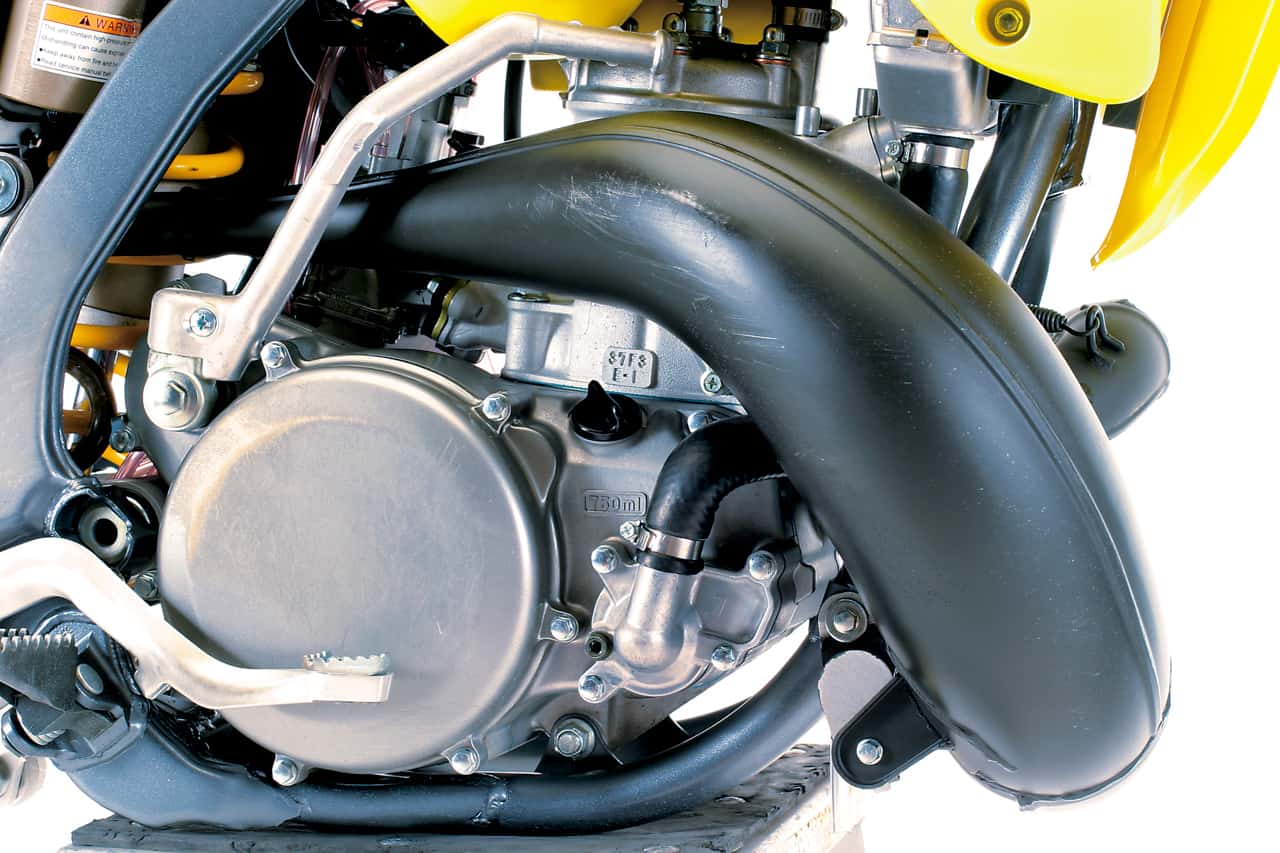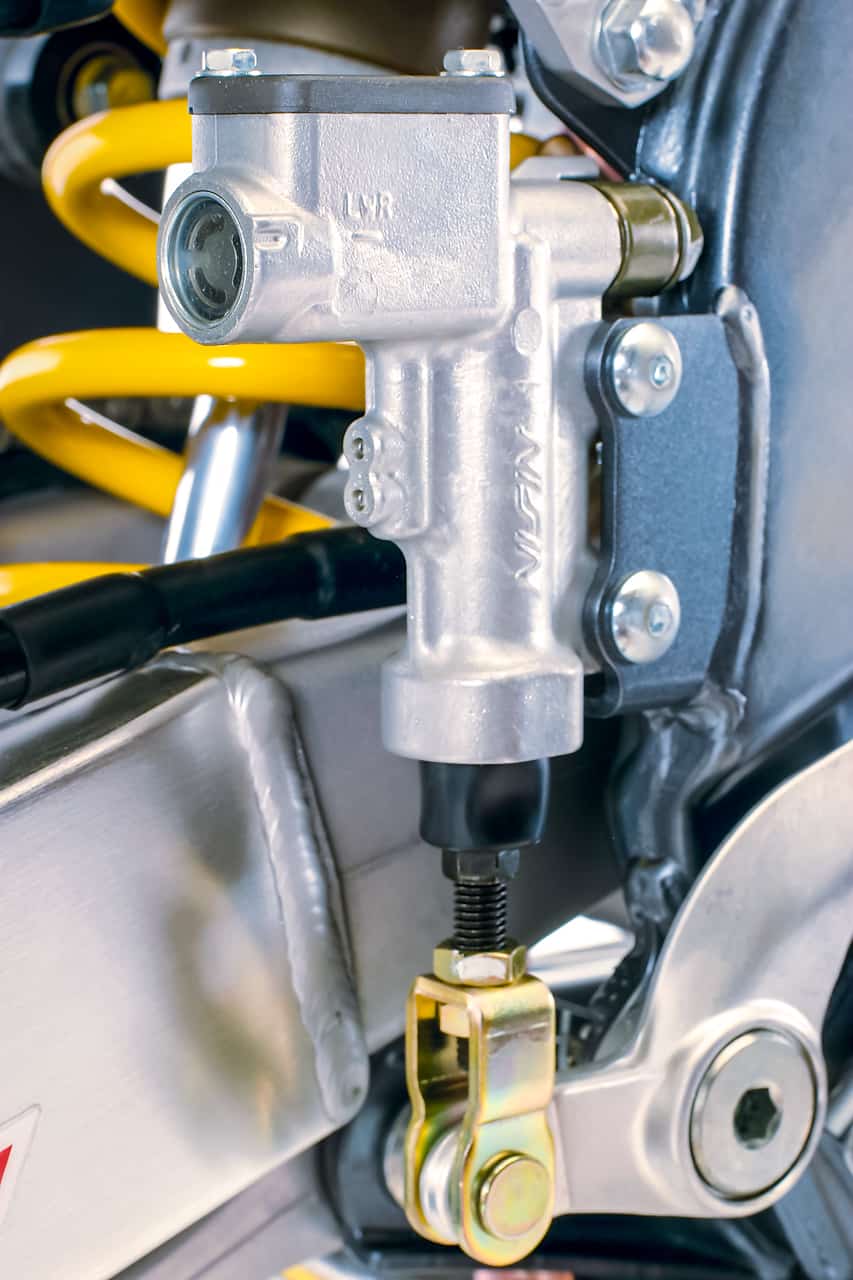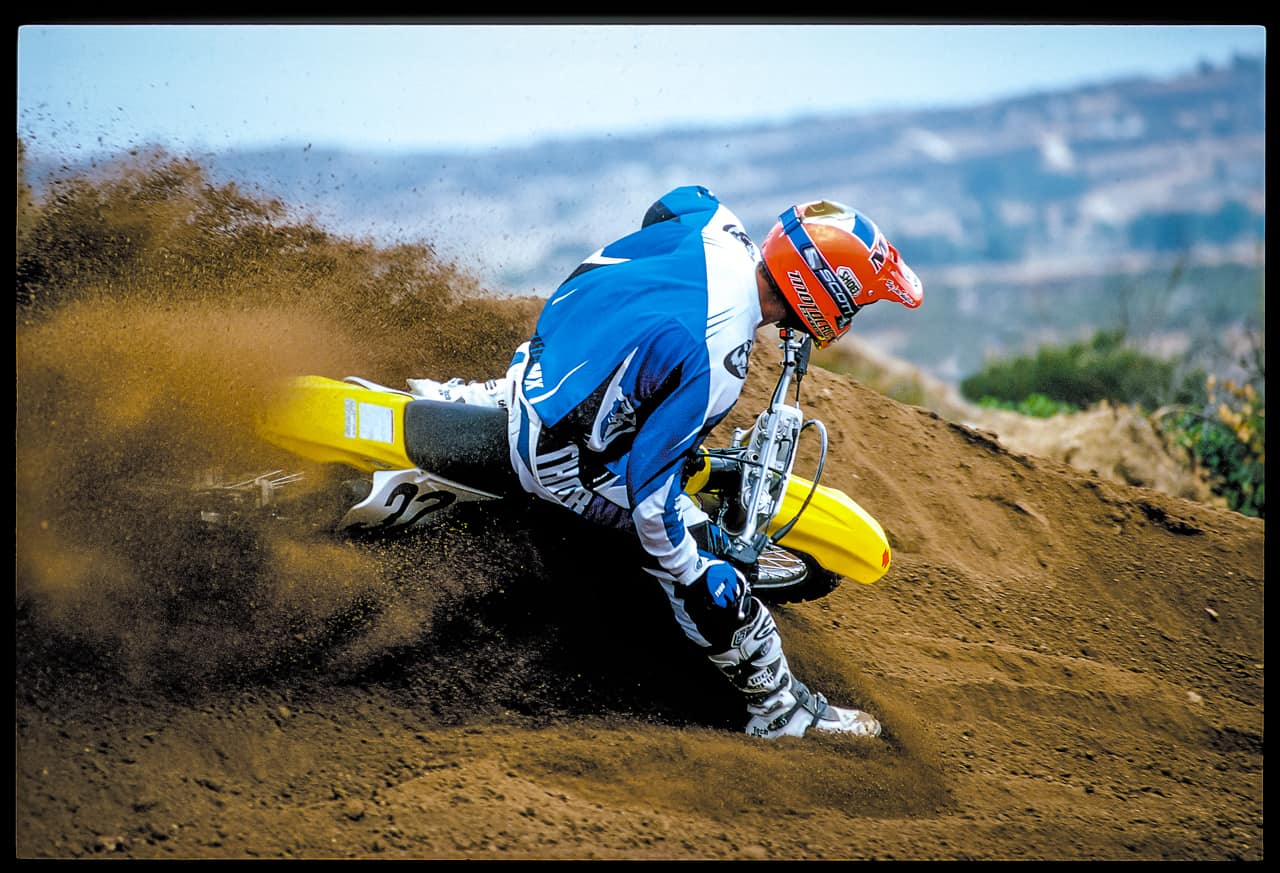MXA RETRO TEST OF THE 2004 SUZUKI RM250
 This Suzuki RM250 test was pulled from the archives of the 2004 January issue of MXA.
This Suzuki RM250 test was pulled from the archives of the 2004 January issue of MXA.
2004 MXA RACE TEST: 2004 SUZUKI RM250
Suzuki has played third or fourth fiddle to the Yamaha, Honda and Kawasaki since 1996 (the last time the RM250 won the “MXA Bike of the Year” award). What held the RMs of the late ’90s back? A little bit of everything. Their light flywheel engines produced punchy power, but not class-winning vibes. Their Showa suspension was always out of balance (one end stiff and the other soft). Their handling was aggressive, but very twitchy. They were quirky machines that demanded more from the rider than the competition. So what changed? The mindset of Suzuki’s engineers.
Tired of pursuing the omnipotent Yamaha YZ250, Suzuki decided that if you couldn’t beat them, you might as well join them. For 2003, Suzuki went in search of Yamaha-style power. And, they achieved it. It was a revelation for Suzuki’s engineers as they leapt from the middle of the 250 pack to the second spot behind the 2003 Yamaha YZ250. Bolstered by the unexpected success of the 2003 RM250, Suzuki bit the bullet and buckled down for an assault on the top spot in 2004.
The result is a terrific bike. It has everything going for it: power, suspension and handling. It may owe a tip of its hat to Yamaha for the cylinder layout, porting and pipe, but the overall package is uniquely Suzuki. It’s slim, trim, agile and quick.
 2004 Suzuki RM250 engine.
2004 Suzuki RM250 engine.Q: IS THE 2004 RM250 ENGINE FASTER THAN THE ’03?
A: Yes, but not because it pumps out quasar ponies. It’s faster because the throttle response is better metered to the power output, and the thrust is commensurate to the angle of the dangle. When translated, that means that the RM250 is easy to ride. Its powerband is not as forceful, dynamic or broad as the class-leading YZ250’s power output, but it always delivers a manageable amount of power at the right time. Most MXA test riders referred to the RM’s power characteristics as “power on demand.”
Q: HOW DOES THE ’04 RM250 COMPARE TO THE ’04 YZ250?
A: Back-to-back test sessions between the RM and YZ proved beyond a shadow of a doubt that the YZ250 was faster, broader and had an innate ability to feel hooked up at all times. By comparison, the RM had marvelous roll-on control, clean pickup off the bottom and a strong midrange. When it came down to the empirical bottom line (engine-to-engine and powerband-to-powerband), the Yamaha YZ250 was better. In a race, however, the difference was not so pronounced. The RM250’s effortless power delivery, responsive thrust and ability to translate minute rotations of the rider’s wrist into forward motion in a millisecond made the RM250 a true contender.
 The RM250 has everything going for it: power, suspension and handling.
The RM250 has everything going for it: power, suspension and handling.Q: WHAT DOES THE RM250 DO ON THE DYNO?
A: It pumps out 45.5 horsepower. Not bad, especially given the RM’s snappy and responsive feel. For comparison, the YZ250 produces 46.6 on the same dyno. But, what is most noticeable is how much stronger than the RM250 the YZ is below 6500 rpm and above 8400 rpm. We aren’t just talking about one horsepower at peak, but almost five horsepower at the bookends.
Which one is faster? The YZ250. Which one is quicker? The RM250. Which one has the most thrust? The YZ250. Which one has the quickest throttle response? The RM250. Which one is best overall? The YZ250.
Q: WHAT DID SUZUKI CHANGE ON THE ENGINE FOR ’04?
A: Lots of cool stuff.
Head: The combustion chamber is reshaped and the squish band has been tightened for better low-end.
Porting: All the ports have been lowered 0.5mm, while the exhaust boost ports have been made 2mm wider and 1mm higher (now they match the height of the exhaust port).
Power valve: The power valves open at a lower rpm, while the governor spring has a higher spring rate.
Crankshaft: The crankshaft weights (flywheels) are positioned slightly out of balance, instead of being symmetrical. The out-of-phase crank doesn’t produce any noticeable vibration in the operating range, but produces a “big bang,” which seems to improve traction.
Shift drum: A new shift drum is mated to a 50 percent stiffer shift detent spring to reduce the tendency to shift by accident.
 The Keihin carburetor on the RM250 had to be leaned out.
The Keihin carburetor on the RM250 had to be leaned out.Q: WHAT ABOUT THE JETTING?
A: We had to lean it out by two main jet sizes. For our sea-level, SoCal, Latte-sipping, race tracks, we ran a 162 main, 48 pilot and NEDJ (optional) needle in the second clip position.
Q: WHAT ABOUT THE GEARING?
A: It is just about perfect for the RM’s power output.
 These Showa 47mm Twin-Chamber forks are were awesome.
These Showa 47mm Twin-Chamber forks are were awesome.Q: HOW GOOD IS THE 2004 RM250 SUSPENSION?
A: In one simple, easy-to-understand term, it is great. No, make that awesome. Or incredible. No, great is the right word.
Forks: Last year the RM250 had Kayaba forks, and while the spring rates were a little suspect, they were on a par with the Kayabas of their prime competitors. For ’04, Suzuki returned to the Showa camp. We had our doubts about switching from a good thing, but it worked out in Suzuki’s favor.
The 47mm Twin-Chamber forks feel firmer, more controlled and better sprung than last year (thanks to stiffer spring rates and better bottoming resistance). The average rider will be able to turn the compression out to 10 and the rebound to 13 and handle almost anything the track throws at him.
Shock: We are talking perfection. This is the best showroom stock rear suspension that we have seen in years. Every MXA test rider loved this shock–without exception. It goes straight through the nastiest stuff. It never kicks, hops or burps. Lines that we avoided on other bikes, we attacked on the 2004 RM250. What made all the difference? Probably the new shock linkage, which Suzuki borrowed from Yamaha for ’04. With the new linkage, the loads are transferred from the frame to the swingarm, while the shock arc smoothes the shock action.
Depending on your track, set the rebound on 12 clicks out, low-speed compression on 10 and high-speed between 1-3/4 and 2 turns out.
Q: HOW DOES IT HANDLE?
A: Suzuki’s engineers have always taken umbrage when the RM’s schizophrenic handling has been called into question. On the “Doctor Hyde” side of the equation, there is no doubt that the RM250 is the quickest turning bike made. It carves better than Wolfgang Puck. Conversely, “Mr. Jekyll” comes into play on fast rough straights when the RM250 shakes like a dog with fleas. Head shake, swaps and religious experiences are not uncommon at speed.
While Suzuki’s designers have rankled at the suggestion that the RM250’s chassis has been skewed too far to the cornering side of the equation, behind the scenes they have been calming the RM down. The head angle got some tweaks a few years ago, and for 2004 the fork offset has been changed from 24.5mm to 22.5mm.
Q: WHAT DO OFFSET, TRAIL AND THE REST OF THE MUMBO-JUMBO MEAN?
A: Skip this paragraph if you don’t want the techno mumbo-jumbo. Less offset, the distance that the centerline of the fork tubes is in front of the center line of the head tube, increases trail. Trail is exactly what it sounds like, the distance that the center of the contact patch of the front tire trails an imaginary line drawn down the centerline of the head tube. Much like the rudder on a boat, trail helps steer a machine. Lots of trail means lots of stability (and a self-steering sensation). Very little trail produces quick, effortless turning, but with a propensity for the contact patch to swivel on its axis. Choppers have lots of trail. Trials bikes have very little trail.
By changing the offset for 2004, Suzuki increased trail, which in turn improved straight-line stability. The addition of a lower seat height (10mm), taller bars (7mm) and rearward peg location (5mm) also help the rider maneuver the RM.
Q: DID THE CHANGE IN OFFSET IMPROVE THE RM’S HANDLING?
A: Yes. The RM250 isn’t as schizo at speed. Oh, there is still more head shake than with the other brands, but not enough to require a St. Christopher medal. Though every now and then you find yourself doing the Juan Pablo Montoya steering whip to keep the handlebars going straight.

Q: WHAT DID WE HATE?
A: The hate list:
(1) Rubber: Unless you race on the hardest of hard dirt, swap the Bridgestone 601/602 tires for the sneakers of your choice (and if you choose to run the 601/602s, snap out of it).
(2) Front brake: Although the RM250 has terrific brakes, a rock that we never saw, or heard, bent one of the arms on the new full-floating rotor carrier. This caused the front brake to pulse.
(3) Clutch: Very grabby. It’s like a sprint car clutch–in or out. No finesse. Lots of chain snatch.
(4) Bars: KTMs and Hondas come stock with aluminum bars. Everybody else, Suzuki included, is off the back.
(5) Rear wheel: Even the savviest of mechanics struggled to get the RM’s rear wheel back on the bike after tire changes. It’s very tight back there.
(6) Tank decals: Gone in sixty seconds.
 For 2004 the RM250 got upgraded reservoirs front and rear.
For 2004 the RM250 got upgraded reservoirs front and rear.
Q: WHAT DID WE LIKE?
A: The like list:
(1) Brakes: Suzuki got Honda-style brake hose routing in 2004, but that wasn’t the only improvement they made. Both the front and rear brakes got new reservoirs.
(2) Shift drum: Don’t get us wrong, previous Suzuki’s were the easiest shifting bikes in the world. Too easy. Riders would often accidentally shift them by bumping the lever with their foot. The new shift drum is much more positive.
(3) Clutch perch: We don’t like the grabby clutch, but we like the on-the-fly adjuster.
Q: WHAT DO WE REALLY THINK?
A: The 2004 Suzuki RM250 is a better all-around bike than the class-leading Yamaha YZ250 — except in the powerband department. Engine to engine, the YZ is better. But if you plan on sending your RM engine out for some coddling, this is a great bike.












Comments are closed.